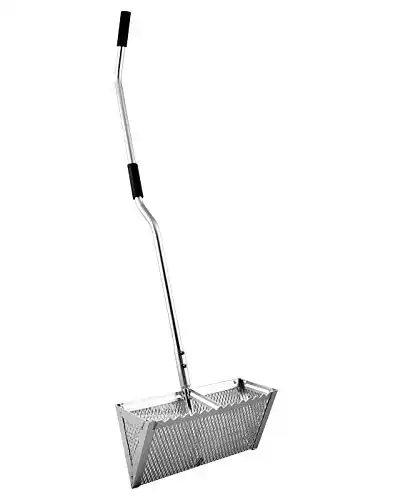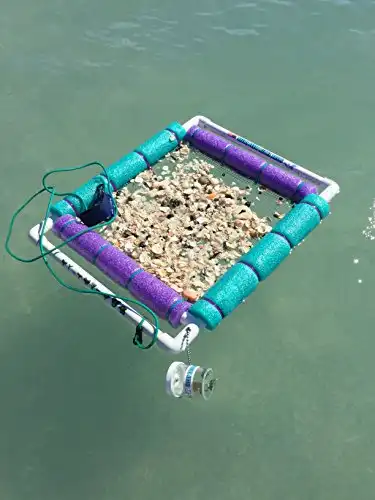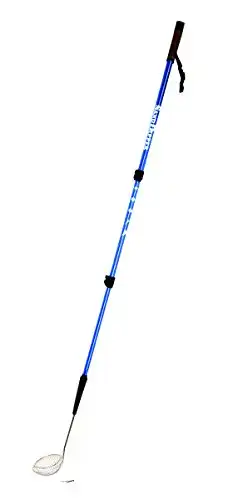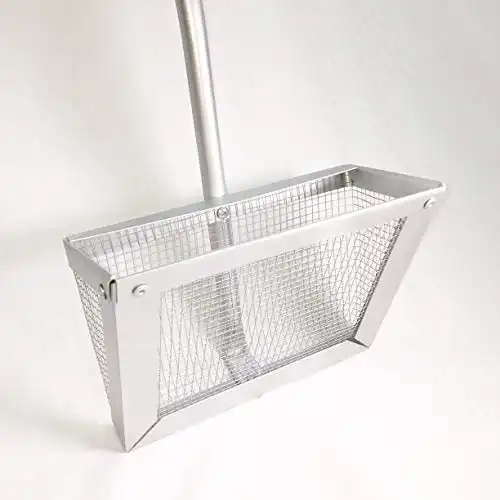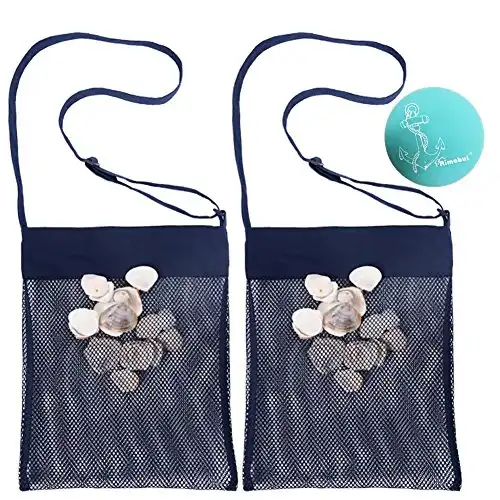Once upon a time, there was a shark so big, that it made the great white shark appear like Nemo. the Megalodons are believed to reach lengths of up to 82 feet, with masses around 140,000 pounds. This is easily the size of a ship.
These creatures aren’t mythological creations like Krakens. They actually roamed the earth, and you could find their fossilized teeth anywhere near the ocean. You can also find teeth from a variety of other sharks buried in the sediment.
And to make this process easy and fun, we put together the best tools for finding shark teeth. In addition to a guide on how to select the right ones.
Read More:
- How to Find Shark Teeth on the Beach (Tips, Techniques and Where To Go)
- The Top 10 Best Places To Find SHARKS TEETH
- The 5 Best Shark Tooth Beaches in Florida
The Top 5 Tools for Finding Shark Teeth Reviewed
Here’s a list of the finest tools you can use for finding shark teeth.
1. Exact Design Sand Flea Rake
This rake is made from durable materials, it’s large, and it has teeth!
You can scoop up generous amounts of sand and sediment each time you dig it in. The width of the rake is about 16 inches, and the wedge-shaped basket is quite spacious as well. It’s made from anodized aluminum, so the salty ocean environment wouldn’t affect it easily.
Furthermore, the actual act of digging is a breeze with the serrated edge of the rake. Most of the other tools are blunt, which requires more force to push them down. Another point that adds to your comfort is the handle design. It’s curved, so you wouldn’t have to bend as you turn the sediment.
The Exact Design rake comes at a high price, but it’s worth every dollar.
2. Shark Tooth Sifter
Going through the sediment inside the water is almost impossible if you don’t have the right sifter. This floating sifter can quickly dispose of the irrelevant sediment through its ¼ inch mesh. Then, you’d have the interesting stuff to go through.
Once you find a shark tooth, you can put it inside the plastic container. The sifter has a 3-6 foot lanyard that you can attach to your arm so it doesn’t drift away.
Or, if you want, you can build your own floating shark tooth by checking out this article I put together.
3. Sand Dipper
This tool isn't for everyone. I'm listing it here for those who just aren't able to reach down and pick things up off the ground as easy as before. So, if you spend much time beachcombing, then you'll want to give this one a try. It's well worth it.
- Great for those with trouble bending down to pick up items.
- Access Hard To Reach Spots
- Stay Dry
- Doubles as a Walking Stick
The sand dipper is rugged, versatile, portable, and it doubles as a hiking pole. That’s not all, this cleverly designed sand scoop actually comes at a great price too.
Sampling the sand that’s deep down in the sea bed isn’t easy. Instead of needing to dive down every time you need to sample the sediment, this sand dipper lets you reach as deep as 64 inches down.
You can also decrease its length in shallow waters and work with its 34 inches shortened length. In fact, this stick is fully collapsible, and it can fold into a 22,5-inch length for easy packaging.
The Sand Dipper is made from aircraft aluminum with the basket from stainless steel. It’s thus weatherproof and lightweight. Both features are much appreciated for the gear we take to the sea.
4. Matlock Trading Company MTC Florida Sand Shovel
If the Exact Design is too big or too expensive, the Matlock rake can be a nice alternative. It comes at almost half the price, and the basket is slightly smaller. It’s still a good-quality tool made from aluminum and stainless steel.
5. Rimobul Sand Away Treasures Mesh Bags
The beach is often full of collective treasures, like the much-coveted shark teeth, seashells, pebbles, calcified seahorses, and a multitude of other artifacts. By the end of the day, you’d probably collected a bunch of interesting stuff. So where would all that go?
A set of mesh bags are the best options for keeping these assorted goodies. The Rimobul pouches are 11 x 13.5 inches, they have handles, and they come in 4 different colors.
How to Select the Right Tools for Finding Shark Teeth
We all like to be the best tools from the get-go. So it’s best to keep in mind some practical considerations that would guide us to the right ones.
Rust-proof Materials
The seaside is a pleasant place, but it’s seriously harsh on metals. Poor quality materials could rust after a few months, and they could become totally useless by the end of the season.
It’s also recommended to rinse and dry your tools prior to storing them, as that would extend their longevity considerably.
Lightweight and Portable
You’d be carrying the sand shovel or rake for quite a while combing the sand. A heavy tool would soon tire you and it would be difficult to cover too much ground with such cumbersome tools.
Furthermore, you’d need to carry a bunch of essentials to the beach. If your tools are compact or lightweight, that’s often better. Ideally, we like to pack up gear that fits nicely a single backpack.
Exploring the beach with friends, family, and kids is a different story though. And a good load of packs is to be expected! Still, the portable gear would give you a clear advantage.
Ergonomic Tools
The best kind of tool is that which doesn’t add unnecessary stress to your body. A grip that molds with your hands or a curved rod that relieves your back from bending is always welcome.
These thoughtful designs aren’t too abundant, and sometimes they come at higher prices. But the resulting comfort you get as you use an ergonomic tool is certainly worth it.
Comprehensive Set of Gear
A rake, scoop, or shovel would bring up the sediment and sand. But, you’d need a sieve to sort through the mix. And once you find the shark tooth that you’ve been looking for, you’d need to pack it up in a container or a pouch.
In addition, it’s hard to wade through the sand or seabed with bare feet. So it’s best to put on a suitable pair of soft shoes. You can add to all that a fun set of shovels, sieves, and colored pouches if the kids are coming along.
Planning the essentials from the outset is always good.
Some Tips for Finding Shark Teeth
Here’s a superb way to plan a day: Spending a wonderful time at the beach and returning with a pouch full of remarkable shark teeth. That definitely sounds amazing, and here are a few tips to make sure it plays out in the finest possible way.
- Practice safety at all times, wear the right gear and make sure you’re fully compliant with all regulations.
- Read about the area you’re targeting.
- Both the historic facts and current information about marine would guide you to the best catch.
- You can find shark teeth inland, on the shore, and in the ocean bed. Florida was once covered by the sea, so the sand holds a lot of hidden treasures.
- Islands are great spots to look for shark teeth.
- The time you choose is important too. After the tide or a storm are incredible times for combing the beach.
- Program your eyes to spot shark teeth in the middle of all the pebbles, sediment, and crushed seashells. Memorize their shape, color, and texture.
- Solo trips are different from expeditions with the kids. Plan each one as needed.
- The right tools add a lot to the fun, and they get you better results. Always get the right ones. If you have kids with you, pick a few colored tools.
- Document your catch as much as possible. It’s nice to know the kind of shark that had these teeth, and whether or not it’s an archaeologic artifact.
- Clean up after you’re done. Leave only footprints on the beach.
- Clean up any plastics or other pollutants that you find on the beach. Nature will love you for it.
FAQs
Combing the shoreline for shark teeth is a rather recent interest among beachgoers. That’s why we hear a lot of questions about the matter. Here are some of the more common inquiries and our best answers to them.
Q: What is the best place to find shark teeth?
You’d be surprised to know that land, sea, ocean, creeks, and islands, are all good places to look for shark teeth. That’s because the earth’s geography changed drastically over the years. And what it’s a big city today, might have been covered by the ocean thousands of years ago.
The beaches are of course the first spot everyone thinks about. And if it’s a place bustling with marine life, then you’d quite possibly come across plenty of shark teeth.
Q: Are shark teeth worth money?
Depending on the state, size, and historic origin of the shark tooth, these artifacts could be quite valuable.
Sharks have inhabited the earth for more than 400 million years. And among the most impressive species is the 60-foot megalodon. Its teeth could be up to 7 inches long and weigh approximately a pound. In fact, a fossilized tooth of a Megalodon could be worth a few thousand dollars.
Q: What should I look for in a shark tooth?
The best shark teeth you can get should be large, well-preserved, and smooth. Also, if you can find historic fossilized teeth, that’s even better. You might even hit the jackpot and find yourself a Megalodon’s tooth!
Shark teeth are actually black. This is the first difference that you should be aware of. And there’s a long list of characteristics that set these artifacts apart from other animal’s remains.
Also, crushed seashells are often mistaken for shark teeth. However, you can verify teeth by the shape of the crown and smoothness of the tooth. You should look at as many shark teeth as you can find. This would program your eyes to spot the right ones.
In Conclusion
Picking up a new hobby is always invigorating. You read a lot about your newfound passion, you collect amazing new artifacts, and you share the good times with the people you care about.
Buying new gear is always part of the fun. Especially, as you build up your comprehensive set of tools that’ll help you in exploring deeper and wider grounds. Hopefully, this roundup of the best tools for finding shark teeth was helpful and inspiring.
- Online rock and mineral club for collectors of all levels!
- Find community with like-minded rock and mineral enthusiasts.
- Monthly Giveaways!
- Free Access to Entire Digital Library of Products (current and future products)*

